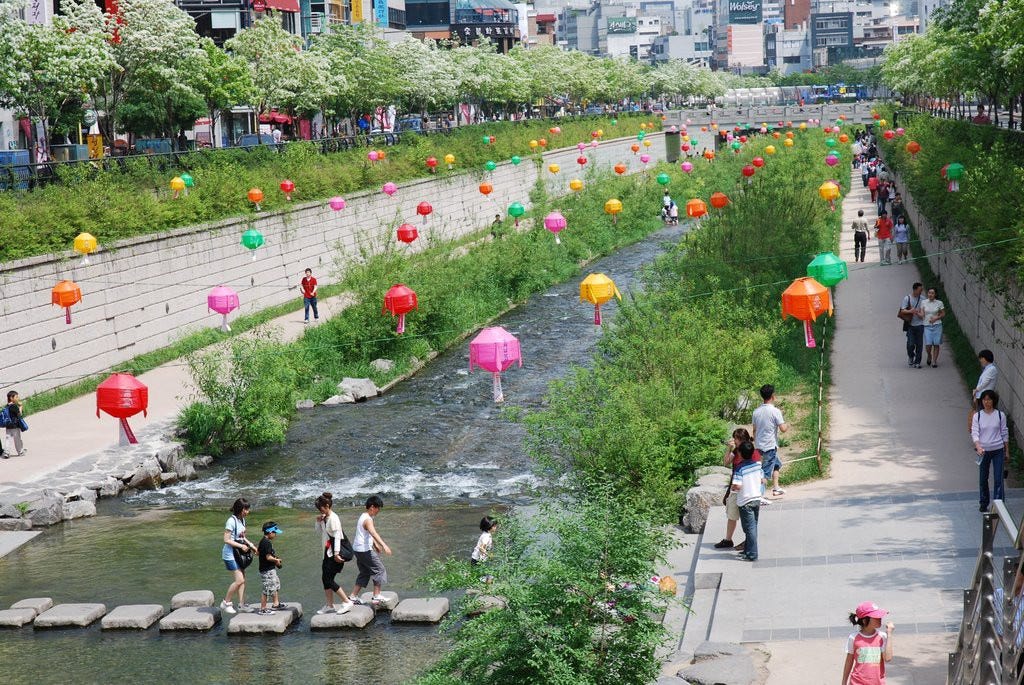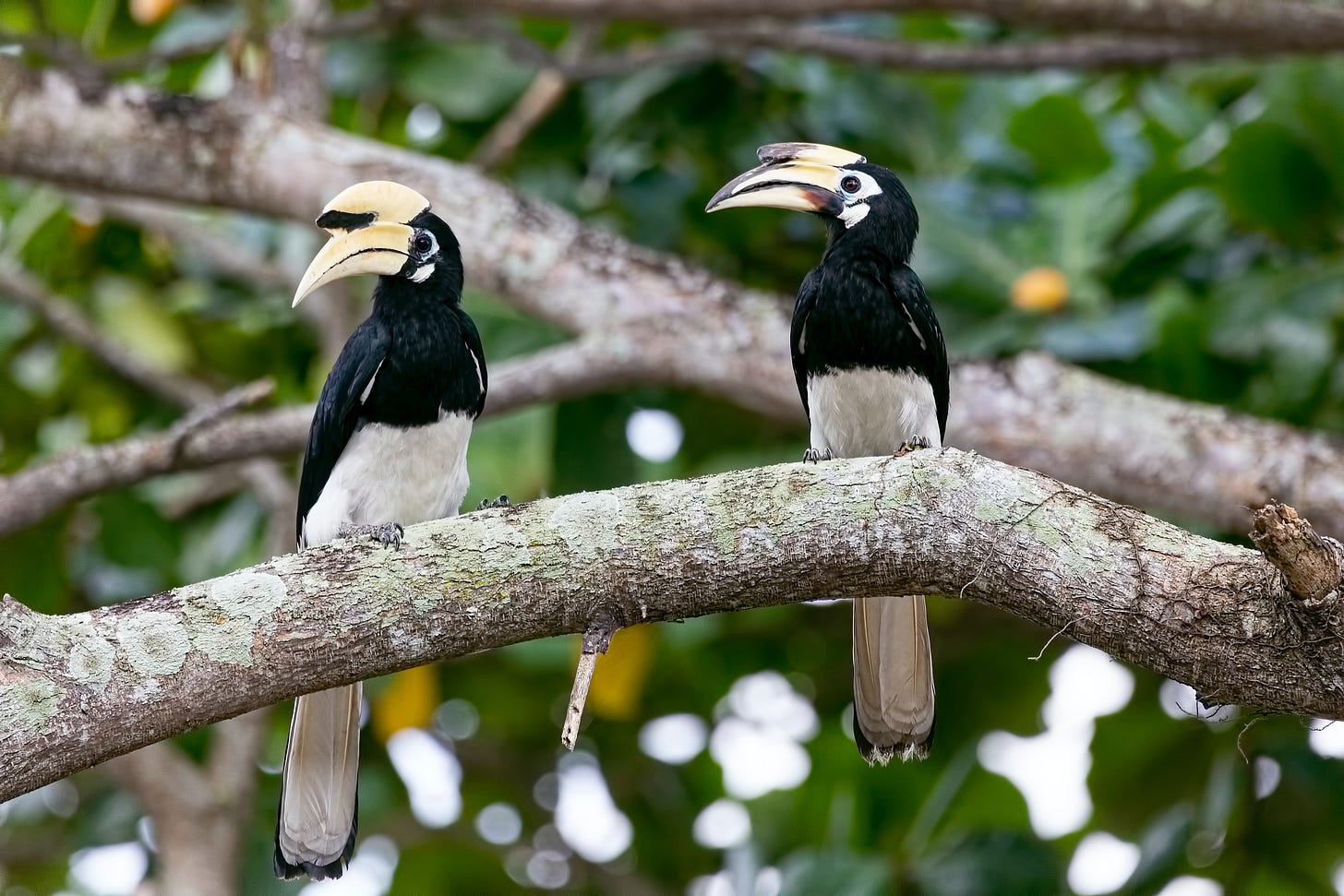🐍 A snake in the city
Biodiversity is still a blind spot for many cities, but bringing back nature could generate important co-benefits for people and the environment. Issue #19
🐍 Hello everyone!
A couple of days ago, I came across a beautiful reticulated python swimming in a water drain, just behind my place in central Singapore. An experience I discussed on LinkedIn. It was both a unique and captivating moment but the most interesting part was actually the reactions of people around me when I shared images of this encounter.
Messages I received ranged from: “Woww, I’m so jealous, I wish I had seen it.. so wonderful” to “OMG, did you call NParks (Singapore’s government agency in charge of nature conservation)? This snake needs to be removed. It’s a real threat” or “Do you think it could enter my house and eat my dogs/cats?”
I am not going to dissert on python-related risks (unless provoked, reticulated pythons actually don’t attack people and are generally inoffensive) but this experience made me think about our relation with nature and how, as an urban species, we sometimes misunderstand the role and importance of biodiversity.
Loss of biodiversity poses as great a risk to humanity as climate change, as underlined by the Intergovernmental Science-Policy Platform on Biodiversity and Ecosystem Services (IPBES - equivalent of the IPCC but for biodiversity) in its 2019 Global Assessment Report on Biodiversity and Ecosystem Services. Yet, biodiversity loss and our mismanagement of nature and wildlife do not always receive the same media coverage as climate change.
What can cities do about this and why, while designing a new neighbourhood or planning for a new infrastructure, we need to think as much about people as about pythons, hornbills and otters?
A snake in the city and why biodiversity matters : that’s our topic for this week.
Hey! I am still running the feedback survey about Cities in Mind. Please take 5 mins to fill it and help me improve the newsletter and the podcast. Eternal gratitude for those who join the survey!
And as always, don’t forget to subscribe to Cities in Mind, spread the newsletter around you or drop this issue into one of your company’s Slack channels to keep the conversation going!
📉 Why Biodiversity is in Free Fall
Climate change is now recognised as a top priority across the globe. And that’s for the best.
But there’s another urgent challenge, threatening life on our planet, that does not gather the same level of attention or benefit from the same efforts of vulgarisation or media discussion: biodiversity loss.
Humans have reshaped the natural world so drastically that ONE MILLION species of animals and plants are currently at risk of extinction.
75% of the world’s land area has been significantly altered by humans which has led to a series of declines in nature. According to the IPBES, natural ecosystems have declined by 47% on average, relative to their earliest estimated states. Approximately 25% of species are already threatened with extinction in most animal and plant groups studied. The global biomass of wild mammals has fallen by 82% since prehistory.

The direct drivers of change in nature with the largest global impact have been (starting with those with most impact): changes in land and sea use; direct exploitation of organisms; climate change; pollution; and invasion of alien species.
Those direct drivers result from an array of underlying causes - the indirect drivers of change - that include: production and consumption patterns, human population dynamics and trends, trade, technological innovations and local through global governance.
It is clear that land habitat destruction and degradation, mainly because of farming, has played a major role in biodiversity loss. At sea, the biggest problem is overfishing and pollution.
Climate change will only increase biodiversity loss as its effects intensify over the coming years. The twin crises of climate change and biodiversity loss are inextricably linked but they could be addressed through different ways.
🌆 Local Actions for Local Results
Now, you’ll ask me, how does it concern cities? Wouldn’t animals be better off in the great wilderness instead of in urban areas?
Biodiversity is a property of a particular ecosystem at a specific location. And as we’ve just seen, one of the key factors behind biodiversity loss is related to land-use and land management. Therefore, local actions regarding natural ecosystems can deliver tangible local benefits for the biodiversity.
Since 1992, urban areas have more than doubled globally and the focus of protecting biodiversity and ecosystem services must now shift to the environments where people live and work.
The BiodiverCities by 2030: Transforming cities’ relationship with nature report, published by the World Economic Forum in January 2022, provides a vision for cities of the future that place nature at the heart of decision-making and infrastructure investments.
In the report, three key actions have been identified as levers for achieving spatial (re)integration of nature in cities:
Preserving existing natural habitats
Renaturing degraded or sub-optimized land
Growing smart with new or upgraded infrastructure
In order to improve biodiversity, cities can invest in both nature-based solutions and land-sparing interventions. Nature-based solutions include actions such as creation of nature ways and green corridors, restoration of watersheds, conservation of mangroves, rehabilitation of coastal areas.. Land-sparing interventions refer to opportunities that release land to nature by reducing the footprint of the built environment, such as repurposing parking lots, retrofitting stranded assets, reducing space used for landfill..
In most instances, nature-based solutions could cost 50% less than grey infrastructure alternatives and deliver 28% in added value (measured in terms of infrastructure productivity), as well as providing gains from positive externalities in the built environment, such as the creation of carbon sinks, cleaner air and water, better health, recreational services, job creation and opportunities for growth in other sectors.

There is significant potential for cities to harness nature-based solutions beyond current levels of investment. The evidence suggests that the investment opportunity could reach $113 billion annually in 2030, which is more than four times greater than current levels. While this constitutes just over 1% of cities’ overall projected spending on infrastructure in 2030, this is markedly larger than today’s share of 0.3%.
Nature-based solutions and land-sparing interventions in cities may not uniformly maximize biodiversity outcomes in all cases. It is important for city leaders to rigorously measure urban nature and set targets using science-based standards and indexes.
And the good news is that there are a lot of tools out there to guide cities in their biodiversity strategies.
The Singapore Index on Cities’ Biodiversity, for instance, is a self-assessment tool used by over 50 cities globally to evaluate and monitor the progress of their biodiversity conservation efforts over time. The recently launched Urban Nature Index from the International Union for Conservation of Nature (ICUN) builds on the Singapore Index and sets robust, transparent and science-based targets to protect and restore nature in cities.
When it comes to biodiversity, acting locally generates important direct local co-benefits, both in terms of quality of life and general resilience.
💚 Nature for Culture
Besides the obvious co-benefits that regenerating natural ecosystems can yield, we also need to recognise the importance of nature for social cohesion.
Urban lifestyles often lead to a sense of disconnection from nature. This feeling of nature disconnection may be reinforced by limited access to nearby nature, increasing time spent indoors, at home, at work, or commuting to and from work. Ask any urbanites how they feel after two years of pandemic and you’ll notice that people wish they could access nature more easily and also improve their mental health.
Many initiatives such as urban gardening, nature observation, citizen science to map nature or environmental education can lift our spirits, replace nature appreciation at the centre of our lifestyles and support biodiversity.
In Singapore, research into public housing corridors has shown that Singaporeans plant a huge diversity of plants outside their homes – a total of 231 different species was found across a survey of 135 housing corridors. Planting native plant species at home helps to conserve natural heritage and may provide a lifeline for native birds and insects.
In Seoul, South Korea, the transformation of the Cheonggyecheon river (once buried under a highway overpass) into a natural stream has helped people reconnect with nature. After the restoration, animal species reappeared and the stream became a popular destination for picnics and cultural events. The project secured flood protection, increased overall biodiversity, reduced the urban heat island effect and lowered small-particle air pollution. The redeveloped area now attracts an average of 64,000 visitors a day, including many foreign tourists.
I have travelled two times to Seoul and the simplicity of the Cheonggyecheon river urban design has never ceased to amaze me.
Note to self: I need to work on that Cheonggyecheon river podcast episode.
‘Nature for culture’ acknowledges the importance of people’s connections with nature, and the benefits of social cohesion, community connection, educational, and spiritual benefits. Nature can provide the space in which urban communities reconnect with ‘place’; establish a sense of belonging that enables social cohesion, health and well-being.

Nature is indeed essential for human existence and good quality of life. As highlighted by the IPBES, most of nature’s contributions to people are not fully replaceable, and some are irreplaceable.
We are embedded in nature and we need to recognise its inherent values, as well as its higher order. Cities can take the lead in bringing back nature to our lives but it’s also up to us to appreciate and cultivate its importance.
🧐 Some resources around this topic
Cities should respond to the biodiversity extinction crisis Cities globally are greening their urban fabric, but to contribute positively to the biodiversity extinction crisis, local governments must explicitly target actions for biodiversity.
Tackling biodiversity challenges from the ground Why local actions regarding natural ecosystems can deliver tangible local benefits for the biodiversity.
Why hornbills and otters returned in Singapore The hornbills are an eye-catching example of the many projects in Singapore aiming to preserve what is left of its biodiversity in an urbanised landscape - a movement that has grown gradually over the last couple of decades.
The story of the Cheonggyecheon river restoration in Seoul By all means, an engineering and urban planning miracle but also a cautionary tale: “The project was supposed to conjure up the image of caring about the environment and history, while bulldozing actual cultural properties as they were in such a hurry to get it done.”
The causes behind the global biodiversity loss and why it is a much bigger challenge than we think (in French)
That’s it for today. I hope you’ve enjoyed this contribution. As usual, a small 💚 at the bottom of this page goes a long way.
Thanks for your support and see you next week for a new issue.
Before leaving, don’t forget to fill the survey and share your views about the newsletter and the podcast!





